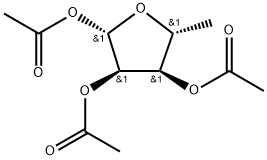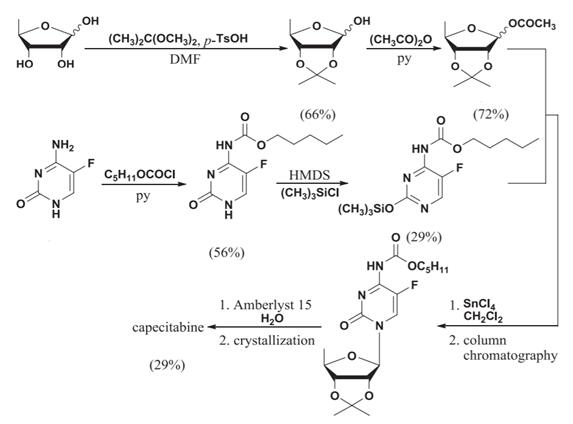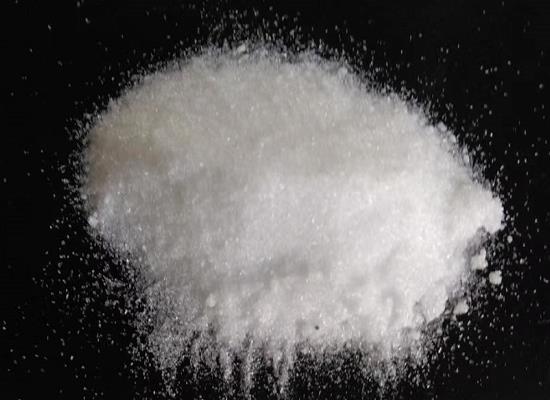1,2,3-Triacetyl-5-deoxy-D-ribose: properties, applications and safety
General Description
1,2,3-Triacetyl-5-deoxy-D-ribose is a white powder with a molecular weight of 260.24 g/mol. It is sparingly soluble in water but readily soluble in organic solvents such as ethanol, acetone, and chloroform. This compound is commonly used as a protecting group for hydroxyl groups on ribofuranose, allowing for precise control of chemical reactions in organic synthesis. It finds significant applications in the synthesis of nucleosides, nucleotides, and pharmaceuticals, including chemotherapy drugs like Cepecitabine. However, caution must be exercised when handling this compound due to its potential health hazards, such as eye and respiratory irritation, as well as potential organ damage with prolonged exposure.

Figure 1. 1,2,3-Triacetyl-5-deoxy-D-ribose
Properties
1,2,3-Triacetyl-5-deoxy-D-ribose is a chemical compound commonly used in organic synthesis. Its chemical formula is C11H16O7, and it has a molecular weight of 260.24 g/mol. From a physical standpoint, 1,2,3-Triacetyl-5-deoxy-D-ribose appears as a white powder with a melting point of approximately 63-64°C. It is sparingly soluble in water, but readily soluble in most organic solvents such as ethanol, acetone, and chloroform. This compound is known for its ability to act as a protecting group for the hydroxyl groups on ribofuranose. This means that it can be selectively deprotected under certain conditions, allowing for precise control of chemical reactions. 1,2,3-Triacetyl-5-deoxy-D-ribose is commonly used in the synthesis of nucleosides and nucleotides, which are important building blocks of DNA and RNA. It is also used in the preparation of various pharmaceuticals, including antiviral and anticancer drugs. In summary, 1,2,3-Triacetyl-5-deoxy-D-ribose is a white powder with selective solubility and is commonly used as a protecting group in organic synthesis. Its properties make it a valuable tool in the production of nucleosides, nucleotides, and pharmaceuticals. 1
Applications
1,2,3-Triacetyl-5-deoxy-D-ribose has a wide range of applications in organic synthesis and pharmaceutical research. It is commonly used as an intermediate in the preparation of various nucleosides, nucleotides, and pharmaceuticals. One of its important applications is in the synthesis of Cepecitabine, a chemotherapy drug used to treat various types of cancer, including breast, colorectal, pancreatic, and gastric cancers. 1,2,3-Triacetyl-5-deoxy-D-ribose e acts as a key intermediate in the production of Cepecitabine, which is converted into 5'-Deoxy-5-fluorocytidine, an active ingredient in the drug. Apart from this, 1,2,3-Triacetyl-5-deoxy-D-ribose is also used in the preparation of various other pharmaceuticals, including antiviral and anticancer drugs. It can be selectively deprotected under certain conditions, allowing for precise control of chemical reactions, making it a valuable tool in pharmaceutical research. In conclusion, 1,2,3-Triacetyl-5-deoxy-D-ribose has significant applications in the pharmaceutical industry, particularly in the production of chemotherapy drugs such as Cepecitabine. Its properties make it a valuable tool in the synthesis of nucleosides, nucleotides, and other pharmaceuticals. 2,3
Safety
1,2,3-Triacetyl-5-deoxy-D-ribose is a chemical compound commonly used in organic chemistry research as a building block for synthesizing various compounds. While it has many useful applications in the laboratory setting, it is important to exercise caution when handling this substance due to its potential health hazards. The compound has been classified as causing serious eye irritation, meaning that it can cause significant discomfort and even damage if it comes into contact with the eyes. It may also cause respiratory irritation, which can be particularly problematic for individuals who suffer from asthma or other respiratory issues. Furthermore, prolonged exposure to this substance may cause damage to organs such as the liver or kidneys. To ensure safe handling of 1,2,3-Triacetyl-5-deoxy-D-ribose, it is crucial to use appropriate personal protective equipment such as gloves, goggles, and a respirator if necessary. The substance should be stored in a well-ventilated area away from sources of heat or ignition. If accidental exposure occurs, affected areas should be flushed with water for at least 15 minutes and medical attention should be sought immediately. Overall, while 1,2,3-Triacetyl-5-deoxy-D-ribose has many valuable uses in research, it is important to handle it with care and take appropriate safety measures to minimize the risk of harm. 4
Reference
1. PubChem. COMPOUND SUMMARY: 1,2,3-Tri-O-acetyl-5-deoxy-beta-D-ribofuranose. National Library of Medicine, 2005, PubChem CID: 11821332.
2. Cook PD, Allen LB, Streeter DG, Huffman JH, Sidwell RW, Robins RK. Synthesis and antiviral and enzymatic studies of certain 3-deazaguanines and their imidazolecarboxamide precursors. J Med Chem. 1978 Dec;21(12):1212-1218.
3. Zhang C, Zuo H, Lee GY, Zou Y, Dang QD, Houk KN, Niu D. Halogen-bond-assisted radical activation of glycosyl donors enables mild and stereoconvergent 1,2-cis-glycosylation. Nat Chem. 2022 Jun;14(6):686-694.
4. (2S,3R,4R,5R)-2,4-bis(acetyloxy)-5-methyloxolan-3-yl acetate. European Chemicals Agency, EC / List no. 612-957-7.
Related articles And Qustion
Lastest Price from 1,2,3-Triacetyl-5-deoxy-D-ribose manufacturers

US $0.00/kg2025-09-01
- CAS:
- 62211-93-2
- Min. Order:
- 1kg
- Purity:
- 99%min
- Supply Ability:
- 20tons

US $5.00-0.50/KG2025-05-16
- CAS:
- 62211-93-2
- Min. Order:
- 0.10000000149011612KG
- Purity:
- 99% hplc
- Supply Ability:
- 5000kg



